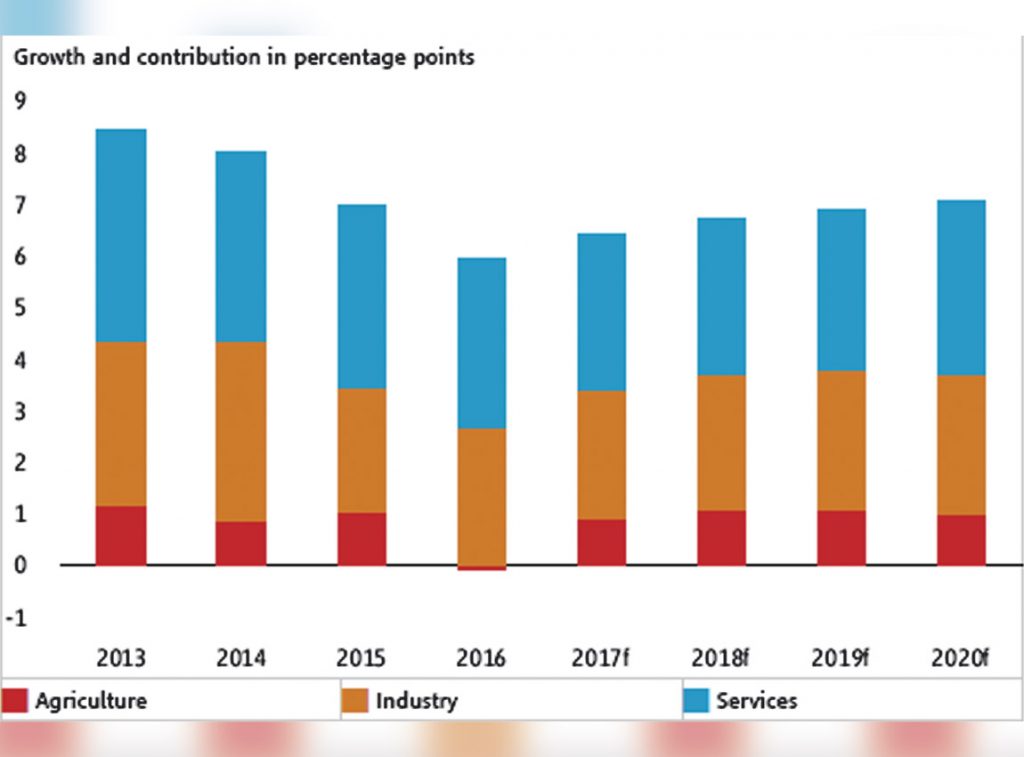World Bank cuts growth forecasts for Myanmar amid slowing investments
The World Bank has cut its growth forecasts for Myanmar, citing that investment demand slowed down as businesses wait for greater clarity of Nay Pyi Taw’s economic agenda.
In its latest report released October 4, it cut Myanmar’s growth forecasts by 0.6 percentage points for 2017-18 to 6.4 percent. Growth over the medium-term is also reduced to an average of 6.9pc per year.
Earlier this year in April, the bank stated that economic growth is projected to average 7.1pc per year over the next three years.
“Myanmar’s macroeconomic environment remains stable, though economic growth is slowing to 5.9pc in 2016-17 compared to 7pc in 2015-16, weighed down by slower investment demand,” the Washington-based lender noted.
Despite notable reforms and strong foreign investment commitments, investment demand decelerated as private investors bided their time pending greater clarity in the government’s economic agenda, the World Bank said.
Businesses in Myanmar appear to have delayed investments as they wait for the government’s economic agenda to become clearer.
– World Bank
Impact of Rakhine
The World Bank’s forecasts have not taken into account the implications of the Rakhine crisis.
“These projections do not factor in any longer-term impact of the ongoing insecurity in Rakhine State, which if it persists could have significant adverse effects by slowing foreign investment.
“The economic impact of the recent insecurity in Rakhine State may be substantial if it deters investors,” it said.
More than half a million Rohingya refugees have fled from the region to Bangladesh in just over a month, according to the United Nations. The current exodus is in addition to hundreds of thousands of Rohingya refugees who fled prior violence in Myanmar. The latest violence began when the Arakan Rohingya Salvation Army (ARSA) terrorists launched deadly attacks on security posts on August 25, prompting Myanmar’s military to launch “clearance operations” to root out the rebels.
Growth potential
What has affected the economy and its growth prospects though, is lower gas prices as well as a recent import ban on pulses and beans, which were two of the challenges highlighted in the World Bank’s report.
However, the institution expects a bounce in agriculture activity in the months ahead. That is likely to support stronger growth in rural incomes and contribute to declining poverty. Poverty is projected to decline from 6.5pc in 2015 to 4pc in 2020 if agricultural demand and incomes translate into higher rural labour demand and wages.
Other areas with potential include construction of infrastructure including power, telecommunications and housing, as well as hospitality services, and financial services.
As a result, inflation is projected to decline to 5.2pc by the year end of 2017-18, thanks to a continued pick up in agriculture output.
Meanwhile, reprioritisation of public investments, government revenue reforms, and higher concessional loan disbursements are expected to help ease fiscal constraints and boost public spending and economic activity. The public sector deficit is projected at 4.3pc of GDP, lower than the 5.9pc in the 2017-18 budget.
However, the current account deficit is projected to increase to 6.8pc of GDP due to a continued decline in gas sector receipts and a pick-up in investment-related imports.
ASEAN prospects
Myanmar isn’t the only country for which the World Bank has lowered its forecasts. Growth projections Cambodia and Laos have also been revised downward, even though both countries, along with Myanmar, will still be among the fastest-growing countries in ASEAN.
Sector contribution to real GDP growth for Myanmar. Graph: World Bank
Cambodia is experiencing a slowing down in construction and garment sectors, whereas construction, flat mining output, and stable public spending have seen moderation in Laos.
The World Bank also reduced the forecast for the Philippines, citing that a delay in a planned government infrastructure program has softened the economic growth prospects.
In contrast, growth in Thailand and Malaysia is expected to accelerate beyond the World Bank’s original forecasts. Thailand’s upward revision is due to robust recovery in exports and agriculture, while Malaysia’s growth is gaining a lift from higher private and public investment and a recovery in international trade.
Source: https://www.mmtimes.com/news/world-bank-cuts-growth-forecasts-myanmar-amid-slowing-investments.html


 English
English





